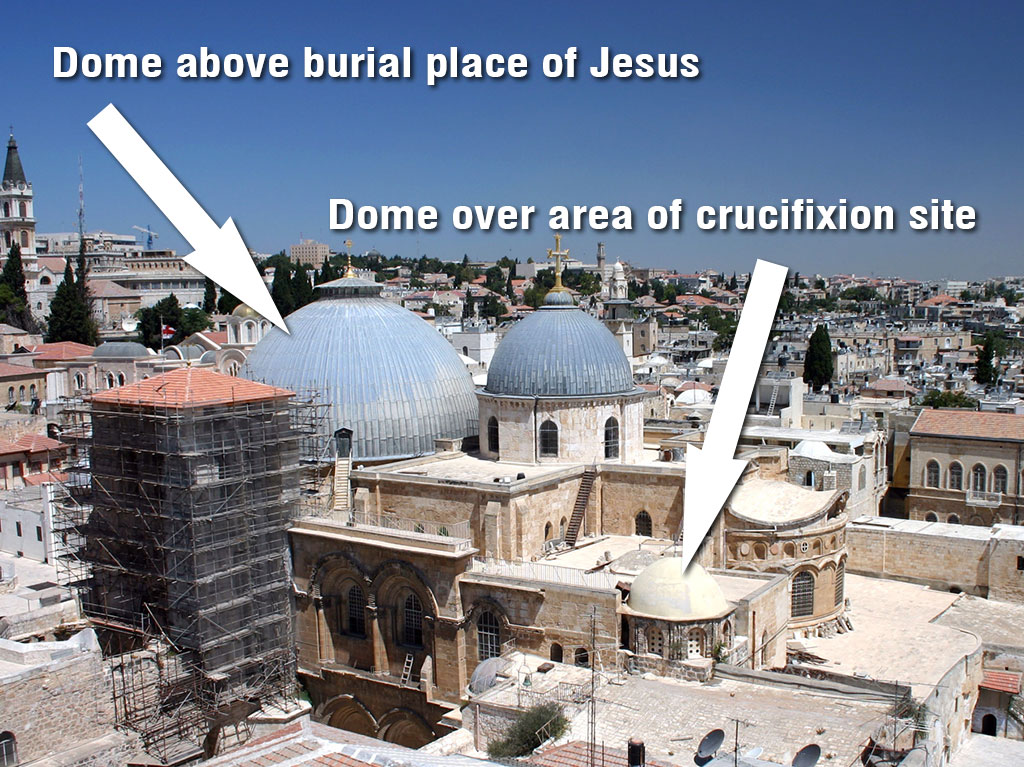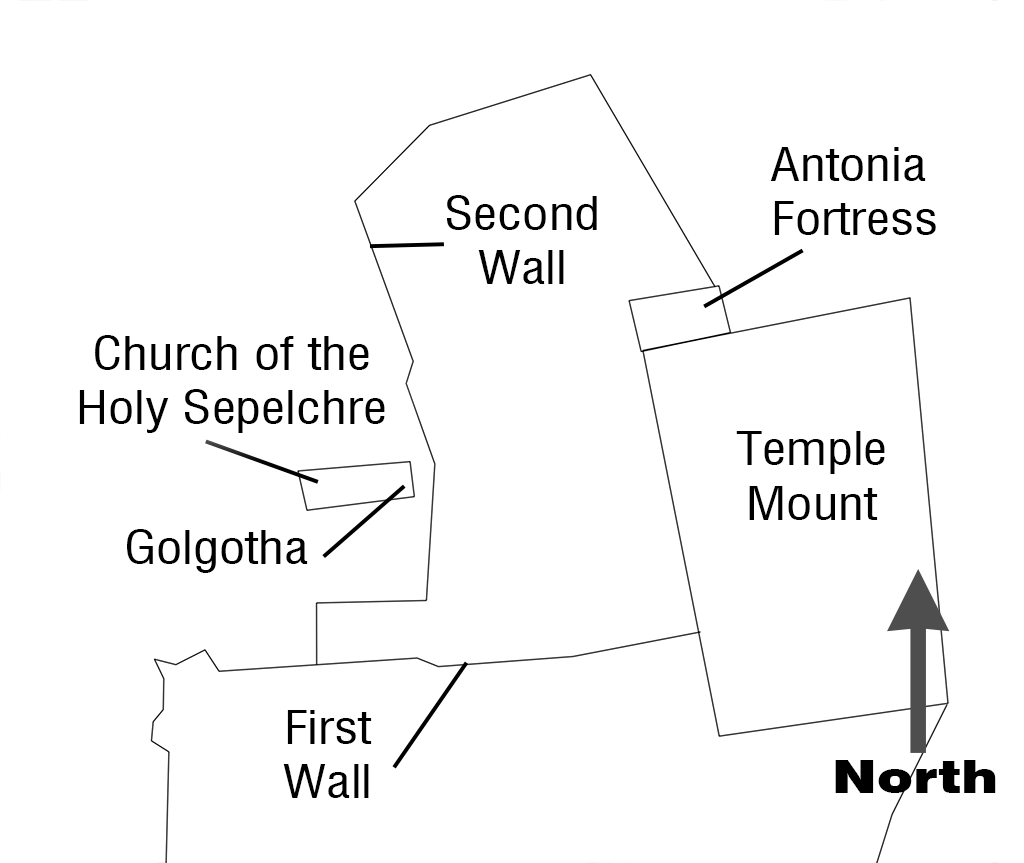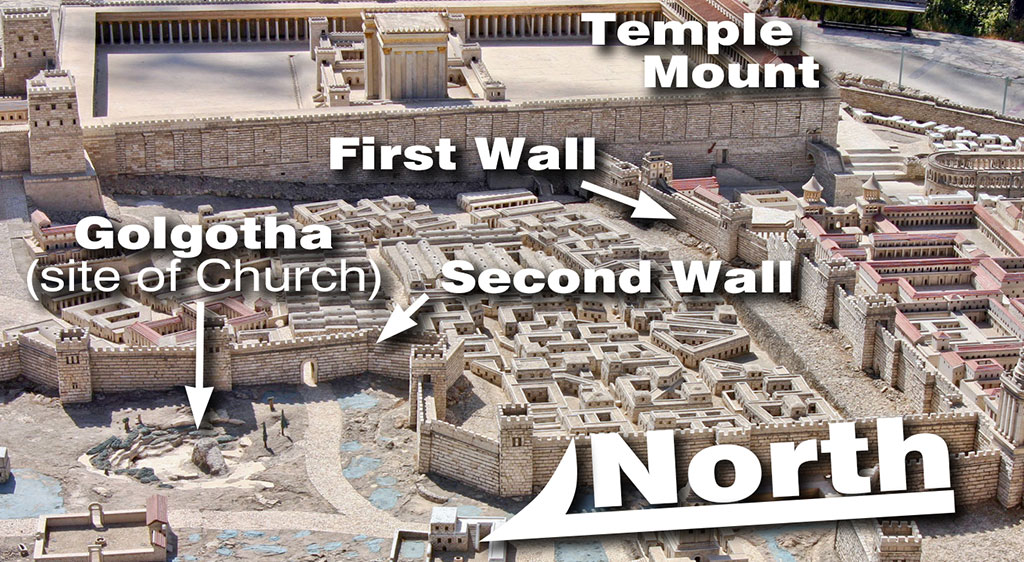The walk along the famous Via Dolorosa (the route taken by Jesus on His way to the cross) ends at the Church of the Holy Sepulchre (subsequently “Church”). It is, quite authentically, the location of the crucifixion, burial, and resurrection of Jesus Christ. It was built in the fourth century and has existed ever since, though not without a series of destructions and rebuilding over the centuries since then. A renewal of archaeological investigation has occurred in the past five years.

Early Years
A large stone quarry, existing back to the ninth century B.C, occupied a portion of the northwestern hill of Jerusalem where the Church would eventually be built. It was probably the source of stone for the construction of buildings and the first and second Jerusalem walls. The quarry had two additional uses: 1) burial caves, and 2) an execution site called Golgotha. At least two first-century burial caves have been found by archaeologists in the quarry. Golgotha was located in the southernmost section of the quarry near the east-west road into the city. The Romans wanted full public visibility of those suffering capital punishment.
Following the Jewish revolt of the 130s, the Romans expelled much of the Jewish population from Jerusalem and converted it into a Roman city, Aelia Capitolina, for the next 200 years. Emperor Hadrian built a pagan temple complex on the very site of Jesus’ crucifixion and burial cave. That’s how it remained until Emperor Constantine I (a.k.a. Constantine the Great) in the fourth century.
Constantine and Beyond
Constantine converted to Christianity early in his reign (A.D. 306-337) and initiated an interest in recovering artifacts and sites associated with Jesus’ life, especially in Jerusalem. Church historian, Eusebius in his Life of Constantine, makes it clear that the locations of Golgotha and Jesus’ burial cave were well known to Jerusalemite Christians in the fourth century – right under the Hadrian temple complex! So, Constantine authorized the demolition of the old Roman temple and voila, a rock-cut tomb was revealed!

Constantine’s engineers disengaged the burial cave from the surrounding bedrock to single out the tomb for display… adorned with columns and masonry, forming the first Edicule, the structure housing the tomb, which has stood in the Church of the Holy Sepulchre in various forms ever since (p. 38).
Immediately the construction of the Church began, “a monument to the resurrection of Christ of such magnificence that it would rival the grandest structures of the empire” (p. 38). Until the 1160s, the Church was called the “Church of the Resurrection.”
When the crusaders recaptured Jerusalem from the Muslims in 1099 (the Muslims had mostly destroyed all Jewish and Christian places of worship), they set about to rebuild it back into a grand edifice. They brought the entire complex under one roof, added the bell tower and several chapels, repaired the Edicule, and incorporated the Rock of Golgotha into the Church proper – and renamed the entire edifice the “Church of the Holy Sepulchre.”
Recent Restoration

The only significant changes to the Church since the twelfth century have focused on the Edicule of the Tomb. It was rebuilt as a small building in 1555; rebuilt in 1809 after a fire; strapped together with steel girders in 1927 due to an earthquake; and in 2016 its pieces were secured with titanium rods.
The millions of pilgrims who tour the Church are not so interested in the Edicule but the burial cave itself. What does it look like? The tomb chamber has a limestone bedrock which was covered by marble in the eleventh century. There is a northern wall about four feet tall, a southern wall about five feet tall, and the burial bench between them. Dating of the mortar where the burial bench and its marble covering meets the limestone bedrock gave a fourth century reading, indicating that the bench was covered with marble at the initial construction. Archaeological investigation of mortar, masonry, and other remains within the Edicule confirm the original fourth century and the eleventh century constructions.

The Church of the Holy Sepulchre has stood for nearly 1,700 years as a testimony that there is forgiveness at the cross of Jesus Christ and evidence that the power of death has been broken (Romans 8:1-2; John 5:24; Luke 24:47-47). While we can find the complex history, the architecture, and the archaeology of the Church fascinating, there is one thing you will not find there – the burial bones/body of Jesus. As all four Gospels proclaim, “He is not here, for He has risen…” (Matthew 28:6).
Source: “The Church of the Holy Sepulchre in Text and Archaeology,” by Justin L. Kelley, Biblical Archaeology Review, Spring 2021, Vol. 47, No. 1, pp. 34-43



